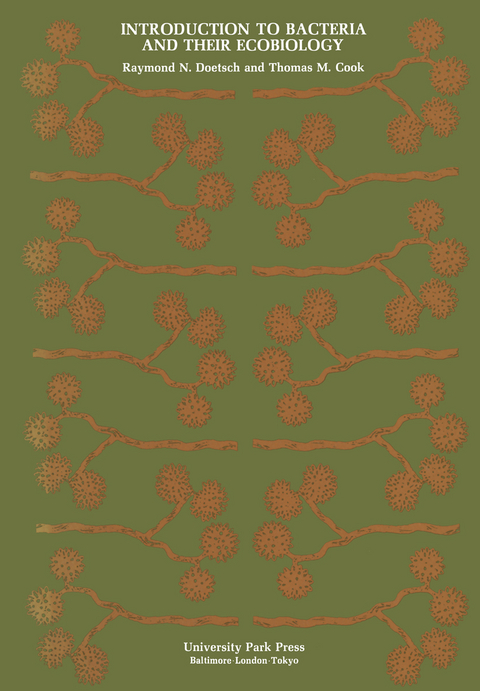
Introduction to Bacteria and Their Ecobiology
Springer (Verlag)
978-94-015-1137-7 (ISBN)
one Bacteria in Nature.- 1.1 The Origin of Bacteria.- 1.2 The Uncertainty of Knowledge Concerning Bacteria.- 1.3 Some Methods for Studying Bacteria in Natural Habitats.- 1.4 Functions of Bacteria in Nature.- References.- two Some General Structural Features of Bacteria.- 2.1 Bacteria as Prokaryotic Forms.- 2.2 Bacterial Shapes and Some Consequences of Their Being Very Small.- 2.3 Capsules.- 2.4 Pili.- 2.5 Flagella and Bacterial Behavior.- 2.6 Cell Walls.- 2.7 The Cytoplasmic Membrane and Its Ramifications.- 2.8 The Nucleus.- 2.9 Ribosomes.- 2.10 Endospores, Cysts, Conidia, and Myxospores..- 2.11 Cytoplasmic Inclusions.- 2.12 Rhapidosomes.- 2.13 Colony Formation.- 2.14 Gross Chemical Composition of Bacteria.- References.- three Heterogeneity of Form and Function.- 3.1 Budding Bacteria.- 3.2 Stalked Bacteria.- 3.3 Ribbon-Forming Bacteria.- 3.4 Fruiting Bacteria.- 3.5 Net-Forming Bacteria.- 3.6 Thiothrix, Leucothrix, and Some “Gliders”.- 3.7 Sphaerotilus and Leptothrix.- 3.8 Filamentous Branching Bacteria.- 3.9 Cell Wall-less Bacteria.- 3.10 Flexible, Helical Bacteria.- 3.11 Blue-Green Algae.- 3.12 Hydrogen Oxidation.- 3.13 Carbon Monoxide Oxidation.- 3.14 Methane Oxidation.- 3.15 Nonsymbiotic Nitrogen Fixation.- 3.16 Sulftir Oxidation.- 3.17 Sulfate Reduction.- 3.18 Luminescent Bacteria.- 3.19 Photosynthetic Bacteria.- 3.20 Extreme Halophiles.- References.- four Populations and Habitats.- 4.1 Bacteria as Open Systems.- 4.2 Multiplication and Growth.- 4.3 Estimating Bacterial Numbers.- 4.4 The Rise and Decline of Bacterial Populations.- 4.5 Biological Aspects of Dormancy in Bacteria.- 4.6 The L-Phase of Bacteria.- 4.7 Bacterial Distribution.- 4.8 Extrinsic and Intrinsic Influences.- 4.9 Temperature Effects.- 4.10 Pressure Effects.- 4.11 Radiant Energy Effects.- 4.12 pHEffects.- 4.13 Oxygen Relationships.- 4.14 Currents and Surfaces.- 4.15 Extrinsic Biological Factors.- 4.16 Habitats.- 4.17 Ecological Aspects of Chemolithotrophy.- 4.18 Bacterial Interactions.- 4.19 Some Exobiological Problems.- 4.20 Gnotobiosis.- References.- five Bacterial Energetics.- 5.1 Enzyme Localization.- 5.2 Energy Sources and Carbon Compounds Used by Bacteria.- 5.3 Energy Metabolism in Bacteria.- 5.4 Characteristic Bacterial Fermentations of Carbohydrates.- 5.5 Fermentation of Noncarbohydrate Materials.- 5.6 Pathways for the Dissimilation of Aromatic Compounds by Bacteria.- 5.7 The Role of Inorganic Compounds in Bacterial Energy Metabolism.- 5.8 Inorganic Compounds as Terminal Electron Acceptors.- 5.9 Some Aspects of the Biochemistry of Chemolithotrophy.- 5.10 Energy Transduction in Bacterial Systems.- 5.11 Bacterial Luminescence.- 5.12 Bacterial Photosynthesis.- References.- six Bacteria as Environmental Determinants.- 6.1 The Age of the Earth and the Beginning of Life.- 6.2 Nonbiological Geochemical Processes.- 6.3 Participation of Bacteria in Cyclic Geochemical Transformations of the Elements.- 6.4 The Carbon Cycle.- 6.5 The Nitrogen Cycle.- 6.6 The Sulfur Cycle.- 6.7 Phosphorus Transformations.- 6.8 Bacterial Degradation of Plant Materials.- 6.9 Chitin Degradation.- 6.10 Bacteria in Relation to Fossil Fuels.- 6.11 Formation of Mineral Deposits by Bacterial Activities.- 6.12 Bacterial Attack on Minerals.- References.- seven Epilogue.
| Zusatzinfo | 126 Illustrations, black and white; 371 p. 126 illus. |
|---|---|
| Verlagsort | Dordrecht |
| Sprache | englisch |
| Maße | 170 x 244 mm |
| Themenwelt | Medizin / Pharmazie ► Medizinische Fachgebiete ► Mikrobiologie / Infektologie / Reisemedizin |
| Medizin / Pharmazie ► Studium | |
| Naturwissenschaften ► Biologie ► Mikrobiologie / Immunologie | |
| ISBN-10 | 94-015-1137-3 / 9401511373 |
| ISBN-13 | 978-94-015-1137-7 / 9789401511377 |
| Zustand | Neuware |
| Haben Sie eine Frage zum Produkt? |
aus dem Bereich


